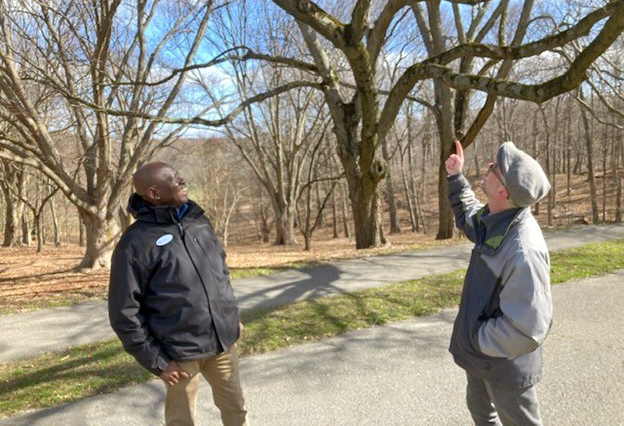Visiting Fellow Gathers Insight for a New Garden in Nigeria
Usman Ibrahim is a Reader (Associate Professor) of Horticulture at the Ahmadu Bello University in Zaria, Nigeria. In May 2021, Usman began a 13-month study leave from the university to participate in the Fellows Program at Longwood Gardens in Kennett Square, Pennsylvania, and as part of that experience he spent eight weeks interacting with staff at the Arnold Arboretum of Harvard University. Over the past 10 years, Usman has been involved in interdisciplinary extension and research programs that support productivity, profitability, and sustainable production of horticultural and field crops in Nigeria. He is the Immediate Past President-in-Council of the Horticultural Society of Nigeria, a member of the founding team for the formation of the Nigerian Public Gardens Association, and a member of the African Center for Horticultural Gardens. Usman returned to Nigeria this July to support the development of public horticulture in Nigeria.
In 2020, Professor Kabiru Bala, the Vice Chancellor of Ahmadu Bello University (ABU) in Zaria, Nigeria, elected me to participate in the Fellows Program at Longwood Gardens. This remarkable opportunity, postponed to spring 2021 due to the global pandemic, would help me learn the skills necessary to support the transformation of our park and gardens at the university into a world-class botanical institution. The fellowship includes a two-month field placement with a partner institution to learn about the structure, organization, and culture of a botanical institution, and for this part of the experience I was delighted to spend time getting to know the staff and operations of the Arnold Arboretum of Harvard University in Boston.
With its long history and strong reputation worldwide, the Arnold Arboretum has inspired the missions, collections, landscapes, curatorial practices, and programming at similar institutions around the globe—a model of how university gardens can serve multiple interests. The Ahmadu Bello University (ABU) Gardens, often described as a “garden in savanna,” is in development to address concerns about rapid and large-scale environmental degradation, pollution, and depletion of natural resources. Our goal in formalizing the garden is to spearhead the incorporation of sustainability and environmental literacy in teaching, research, operations, and outreach at the university and in Nigeria through tree planting and a reforestation campaign.
Our plans to establish this garden arise from the work of our university tree planting committee to arrest further environmental degradation, provide a conducive environment for living and learning, and to protect the major local source of drinking water—Kubanni Dam—from siltation and chemical pollution. Protecting this vital resource will be pursued through the creation of a protective “green belt,” a forest that will also serve as a carbon sink for sustainable development. With these urgent priorities in mind, I hoped to gain valuable insight into how a botanical institution like the Arnold aligns its activities with its mission and the evolving needs of society.

I began my research by mining information resources like the Arboretum website, reports from the Visiting Committee, institutional publications, policy manuals, and other documents. Diving deeper, I interviewed staff and participated in group discussions and meetings at both strategic and operational levels. I learned and observed a full range of care for Arboretum plants, including protocols for evaluating plant health, assessing tree hazards, corrective pruning measures, integrated pest management (IPM) practices, measures to improve soil health, and the use of geographic information systems for mapping, plant documentation, and decision-making. The Arboretum is at the forefront of developing initiatives that promote best horticultural practices and achieve significant energy efficiencies for environmental sustainability.
The findings I compiled for my report catalog major takeaways and recommendations in support of adopting and adapting many of the Arboretum’s current practices. This knowledge will be essential as I develop a two-year action plan for our university’s garden focused on achieving three goals. First, we will develop strategies to spearhead the incorporation of sustainability and environmental literacy in teaching, research, operations, and outreach in our country and its universities. Second, we will focus on initiatives to combat climate change, reduce environmental degradation, pollution, and the depletion of our natural resources. Finally, we will focus on developing a dedicated staff of experts for the garden.
These actions are designed to address challenges associated with ABU’s first 20-year collection plan (1999-2019), which called for cultivation across 2,000 hectares of some 800,000 plants. Unfortunately, our aspirations for this plan fell short. By 2020, a total of only 160 hectares had been planted and only 58,870 trees survived. Going forward, our living collections team will develop a comprehensive collection management policy for our aspirational one million tree collection, work to improve current operations at our greenhouse, and improve the horticulture and landscape maintenance of the public garden by adopting practices gleaned from the Arboretum’s Landscape Management System. Also, like the Arnold, we will work to develop synergy with other units of the university and relevant organizations within and outside Nigeria—particularly in engaging our neighbors and creating a greater sense of belonging, access, and equity with local communities.
Learning all about the Arnold Arboretum provided me with valuable perspectives to address the many challenges we face in stewarding a collection as well as our relationship with the public. Importantly, the experience offered insights into how we might structure the departments at our garden at Ahmadu Bello University through key elements of the Arboretum’s successful model, as well as understanding pitfalls we might encounter in adapting and implementing this model. I believe that my experience at the Arnold will help immeasurably in achieving success in the development of the Ahmadu Bello University Gardens and in supporting the development of public horticulture and greater sustainability in Nigeria.
